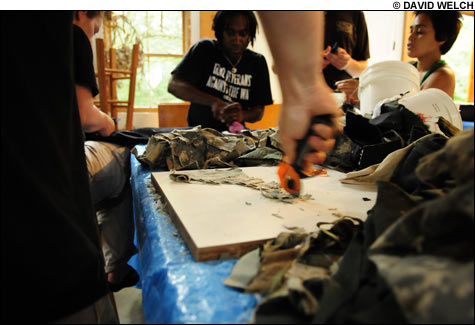
PAPER VICTORY: At Combat Paper workshops, veterans cut up old military uniforms, then transform the pieces into paper pulp and works of art. |
“Dude, that shit right there? That’s Iraq.”
Aaron Hughes, tall, lanky, and blond, held a handful of sand — the stuff that poured out when, with one rip, the 26-year-old veteran split his standard-issue camouflage shorts at the seam. “One year, three months, and seven days. I was stationed in Kuwait and drove a truck back and forth to Iraq,” he says at a workshop on Martha’s Vineyard, tearing his shorts into thin strips. “It’s a long time.” Hughes last touched those shorts when he stepped off the plane from Iraq in 2004.
Hughes, a Chicago native, is one of a growing number of veterans from Boston to Los Angeles who are taking their uniforms out of the closet — seizing the buttons off their Navy blues, ripping their undershirts, and shredding their Army fatigues. Then, in workshops across the country, such as the one in the Vineyard, the vets mix the government-issue rags with water and beat the fibers down to pulp. At the end of the day, the uniforms are reborn as an artistic form of paper. They call it Combat Paper.
“I have a love/hate relationship with my deployment,” says Hughes. “I speak against the war, but I still miss my cot. I only had two uniforms and I wore them every day. It was a security blanket. When you’re cold, you wrap yourself in your shirt. You use it as your pillow. But it’s also a uniform, a symbol of oppression, power, control, and obedience. To turn it into something else is liberating.”
DIY therapy
Drew Cameron, a Vermont-based Iraq War vet who started the controversial Combat Paper project in May 2007, also describes the healing that comes when a veteran takes apart his or her uniform and gives it new life as “a liberating act. It’s deconstruction in a literal and metaphorical way. We are deconstructing memories and experiences while at the same time cutting up, taking apart, and remaking our uniforms.”
It is a healing process independent of psychologists and psychiatrists, a deliberate move since the Veterans Administration benefits offered to returning vets often do not include proper therapy. “It’s a purposeful activity that is self-initiated in a group,” says Sharan Schwartzberg, professor of occupational therapy at Tufts University Graduate School of Arts and Sciences. “The activity is transformative and it has symbols. . . . It can be so supportive.”
According to a November 2007 CBS News investigatory report, US veterans are committing suicide at a higher rate than American servicemen and -women are being killed in combat. Vets in their early 20s commit suicide two to four times as often as their civilian peers. The Combat Paper Project gives vets a chance to fight back against their trauma — taking the horrors of war from the battlefield into the studio, sharing their experiences with other veterans, and remaking those experiences into something entirely new.
Cameron learned papermaking from his father, a veteran himself and an art teacher. After six years in the army — four in the military and two more in the National Guard — Cameron moved to Vermont and took a $10 papermaking course at a community college. Something clicked. He began practicing the trade out of the Green Door Studio artists’ collective in Burlington. “I was drawn to this idea of recreating things into something new,” he says.
One night back in 2007, Cameron took his old fatigues out of the closet. “I hadn’t put that thing on my body since Iraq,” he says. “I was thinking about it systematically at first. Where do I cut? Well, I’ll start with my left arm. Then I started feeling this overwhelming feeling of empowerment and emotional expression. I started ripping and pulling at my uniform until I was down to my skivvies.” From those scraps he created the first sheet of Combat Paper.
Along with fellow Green Door artist Drew Matott, who is not a vet, Cameron began contacting local veterans, inviting them to dig out and recycle their uniforms into paper. Organizers and past project participants host workshops across the country — often on university campuses, which, in addition to contacting local activist-veterans groups, is an ideal way to attract participants, says Cameron, since many young returning vets enroll in college.
“To hear the ripping of the fabric and just knowing that that’s it — that sound just symbolized basically the conclusion I had with the military,” says Liam Madden, treasurer of the Boston chapter of Iraq Veterans Against the War (IVAW), co-chair of its national parent organization, and one of the first vets to sign on to the project.
Not all vets are onboard with the idea of tearing up an American military uniform. “The uniform is a token and a part of what American soldiers, sailors, and Marines have fought for over the years,” says Bob Sinclair, National Service Officer for Disabled American Veterans of Massachusetts. “I certainly do not agree with the defacing or mutilation or tearing up of uniforms.”